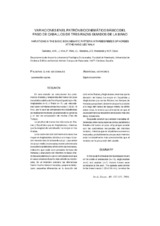Mostrar el registro sencillo del ítem
Variaciones en el patrón biocinemático básico del paso de caballos de tres razas guiados de la mano
| dc.contributor.author | Vivo Rodríguez, J. | es_ES |
| dc.contributor.author | García-Monterde, J. | es_ES |
| dc.contributor.author | Cano, M.R. | es_ES |
| dc.contributor.author | Miró Rodríguez, F. | es_ES |
| dc.contributor.author | Morales López, J.L. | es_ES |
| dc.contributor.author | Martínez Galisteo, A. | es_ES |
| dc.date.accessioned | 2010-05-24T07:10:18Z | |
| dc.date.available | 2010-05-24T07:10:18Z | |
| dc.date.issued | 1999 | |
| dc.identifier.issn | 1885-4494 | |
| dc.identifier.uri | http://hdl.handle.net/10396/3426 | |
| dc.description.abstract | In this study the lineal and temporal parameters of the stride of andalusian (n=10), angloarabian (n=6) and arabian (n=7) mature horses were compared at the walk. The speeds were similar in the three breeds (1.63±0.10 m/s), for what the Archivos de zootecnia vol. 48, núm. 183, p. 328. GALISTEO ET AL. statistical comparisons were carried out by an analysis of the variance, and a means comparison test (Tukey test). The stride lenght was shorter in arabians and andalusians than in angloarabians, while the overtracking lenght was bigger in the arabians. The duration of the forelimb cycle was bigger in angloarabians due to a bigger duration in this breed of the stance phase. The midstace position (expressed as a percentaje of the stride duration) differed among the three breeds, indicating that each one shows times of braking and propulsion of the forelimb different to the other ones; but not in the instant in which the hoof reaches the highest point in its trajectory. In the hind limb the differences were much less marked, since small differences were detected in the duration of the cycle between arabians and angloarabians, while the stride duration was longer in andalusians and angloarabians than in the Arabians; the braking and propulsion phases (determined by the position along the stride of the midstance position) didn’t differ among breeds, the same with the instant in which the hindhoof reach the highest point in its trajectory. It can be concluded that marked differences exist between equine breeds in the lineal parameters of the stride at the walk, and the temporal parameters of the forelimb, while in the hind limb are less marked, probably because this member is functionally committed in the propulsion of the horse. | en |
| dc.description.abstract | En este estudio se compararon los parámetros lineales y temporales del tranco de paso de caballos adultos de Pura Raza Española (n=10), Angloárabe (n=6) y Árabe (n=7). Las velocidades fueron similares en las tres razas (1,63±0,10 m/s), por lo que las comparaciones estadísticas se realizaron mediante un análisis de la varianza y un test de comparación de medias (Test de Tukey). La amplitud de tranco fue más corta en Árabes y Españoles que en Angloárabes, mientras que la longitud de sobrehuella fue mayor en los Árabes. La duración del ciclo del miembro torácico fue mayor en Angloárabes debido a una mayor duración en esta raza de la fase de apoyo. La posición de apoyo medio (expresada porcentualmente a la duración total del ciclo) difirió entre las tres razas, indicando que cada raza presenta tiempos de frenada y propulsión del miembro torácico diferentes a las demás; no así en el instante en el que el casco alcanza el punto más alto de su trayectoria. En el miembro pelviano las diferencias fueron mucho menos marcadas, ya que se detectaron pequeñas diferencias en la duración del ciclo entre Árabes y Angloárabes, mientras que la duración del tranco fue mayor en Españoles y Angloárabes que en los Árabes; los tiempos de frenada y propulsión (determinada por la posición a lo largo del tranco del apoyo medio) no difirió entre razas, lo mismo que el instante en que el casco pelviano se encuentra en el punto más alto de su trayectoria. Se puede concluir que existen marcadas diferencias entre razas equinas en los parámetros lineales del tranco al paso, al igual que sucede con los parámetros temporales del miembro torácico, mientras que en el pelviano son menos marcadas, probablemente porque este miembro está funcionalmente más comprometido que el torácico en la propulsión del caballo. | es_ES |
| dc.format.mimetype | application/pdf | es_ES |
| dc.language.iso | spa | es_ES |
| dc.publisher | Universidad de Córdoba, Servicio de Publicaciones | es_ES |
| dc.rights | https://creativecommons.org/licenses/by-nc-nd/4.0/ | es_ES |
| dc.source | Archivos de zootecnia 48 (183), 327-335 (1999) | es_ES |
| dc.subject | Locomoción equina | es_ES |
| dc.subject | Caballos | es_ES |
| dc.title | Variaciones en el patrón biocinemático básico del paso de caballos de tres razas guiados de la mano | es_ES |
| dc.title.alternative | Variations in the basic biokinematic pattern in three breeds of horses at the hand-led walk | en |
| dc.type | info:eu-repo/semantics/article | es_ES |
| dc.relation.publisherversion | http://www.uco.es/organiza/servicios/publica/az/az.htm | es_ES |
| dc.rights.accessRights | info:eu-repo/semantics/openAccess | es_ES |

